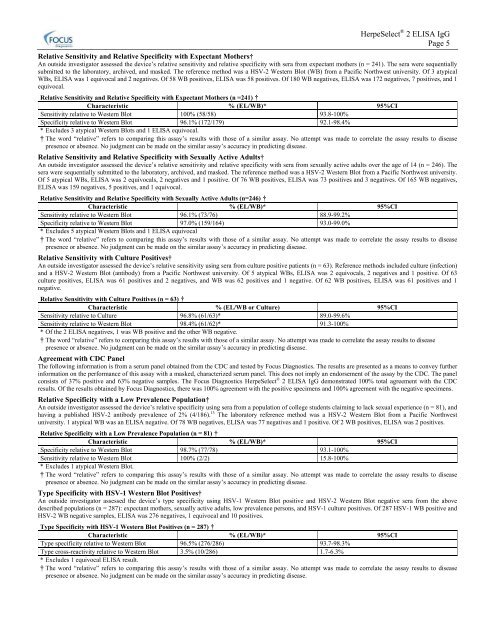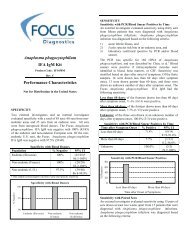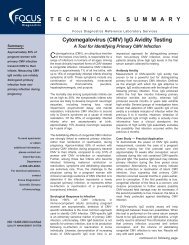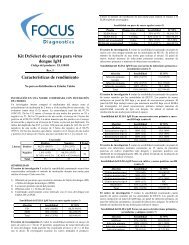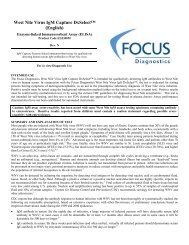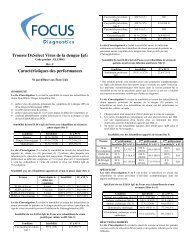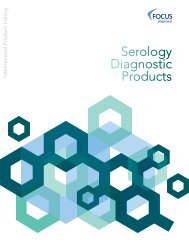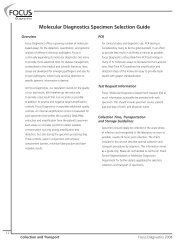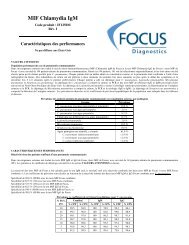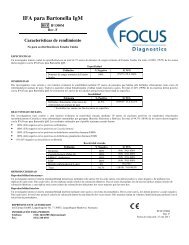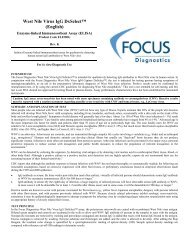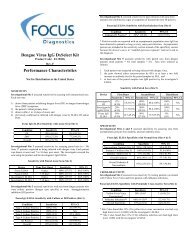HerpeSelect® 2 ELISA IgG test is intended for - Focus Diagnostics
HerpeSelect® 2 ELISA IgG test is intended for - Focus Diagnostics
HerpeSelect® 2 ELISA IgG test is intended for - Focus Diagnostics
- No tags were found...
You also want an ePaper? Increase the reach of your titles
YUMPU automatically turns print PDFs into web optimized ePapers that Google loves.
HerpeSelect ® 2 <strong>ELISA</strong> <strong>IgG</strong>Page 5Relative Sensitivity and Relative Specificity with Expectant Mothers†An outside investigator assessed the device’s relative sensitivity and relative specificity with sera from expectant mothers (n = 241). The sera were sequentiallysubmitted to the laboratory, archived, and masked. The reference method was a HSV-2 Western Blot (WB) from a Pacific Northwest university. Of 3 atypicalWBs, <strong>ELISA</strong> was 1 equivocal and 2 negatives. Of 58 WB positives, <strong>ELISA</strong> was 58 positives. Of 180 WB negatives, <strong>ELISA</strong> was 172 negatives, 7 positives, and 1equivocal.Relative Sensitivity and Relative Specificity with Expectant Mothers (n =241) †Character<strong>is</strong>tic % (EL/WB)* 95%CISensitivity relative to Western Blot 100% (58/58) 93.8-100%Specificity relative to Western Blot 96.1% (172/179) 92.1-98.4%* Excludes 3 atypical Western Blots and 1 <strong>ELISA</strong> equivocal.† The word “relative” refers to comparing th<strong>is</strong> assay’s results with those of a similar assay. No attempt was made to correlate the assay results to d<strong>is</strong>easepresence or absence. No judgment can be made on the similar assay’s accuracy in predicting d<strong>is</strong>ease.Relative Sensitivity and Relative Specificity with Sexually Active Adults†An outside investigator assessed the device’s relative sensitivity and relative specificity with sera from sexually active adults over the age of 14 (n = 246). Thesera were sequentially submitted to the laboratory, archived, and masked. The reference method was a HSV-2 Western Blot from a Pacific Northwest university.Of 5 atypical WBs, <strong>ELISA</strong> was 2 equivocals, 2 negatives and 1 positive. Of 76 WB positives, <strong>ELISA</strong> was 73 positives and 3 negatives. Of 165 WB negatives,<strong>ELISA</strong> was 159 negatives, 5 positives, and 1 equivocal.Relative Sensitivity and Relative Specificity with Sexually Active Adults (n=246) †Character<strong>is</strong>tic % (EL/WB)* 95%CISensitivity relative to Western Blot 96.1% (73/76) 88.9-99.2%Specificity relative to Western Blot 97.0% (159/164) 93.0-99.0%* Excludes 5 atypical Western Blots and 1 <strong>ELISA</strong> equivocal† The word “relative” refers to comparing th<strong>is</strong> assay’s results with those of a similar assay. No attempt was made to correlate the assay results to d<strong>is</strong>easepresence or absence. No judgment can be made on the similar assay’s accuracy in predicting d<strong>is</strong>ease.Relative Sensitivity with Culture Positives†An outside investigator assessed the device’s relative sensitivity using sera from culture positive patients (n = 63). Reference methods included culture (infection)and a HSV-2 Western Blot (antibody) from a Pacific Northwest university. Of 5 atypical WBs, <strong>ELISA</strong> was 2 equivocals, 2 negatives and 1 positive. Of 63culture positives, <strong>ELISA</strong> was 61 positives and 2 negatives, and WB was 62 positives and 1 negative. Of 62 WB positives, <strong>ELISA</strong> was 61 positives and 1negative.Relative Sensitivity with Culture Positives (n = 63) †Character<strong>is</strong>tic % (EL/WB or Culture) 95%CISensitivity relative to Culture 96.8% (61/63)* 89.0-99.6%Sensitivity relative to Western Blot 98.4% (61/62)* 91.3-100%* Of the 2 <strong>ELISA</strong> negatives, 1 was WB positive and the other WB negative.† The word “relative” refers to comparing th<strong>is</strong> assay’s results with those of a similar assay. No attempt was made to correlate the assay results to d<strong>is</strong>easepresence or absence. No judgment can be made on the similar assay’s accuracy in predicting d<strong>is</strong>ease.Agreement with CDC PanelThe following in<strong>for</strong>mation <strong>is</strong> from a serum panel obtained from the CDC and <strong>test</strong>ed by <strong>Focus</strong> <strong>Diagnostics</strong>. The results are presented as a means to convey furtherin<strong>for</strong>mation on the per<strong>for</strong>mance of th<strong>is</strong> assay with a masked, characterized serum panel. Th<strong>is</strong> does not imply an endorsement of the assay by the CDC. The panelcons<strong>is</strong>ts of 37% positive and 63% negative samples. The <strong>Focus</strong> <strong>Diagnostics</strong> HerpeSelect ® 2 <strong>ELISA</strong> <strong>IgG</strong> demonstrated 100% total agreement with the CDCresults. Of the results obtained by <strong>Focus</strong> <strong>Diagnostics</strong>, there was 100% agreement with the positive specimens and 100% agreement with the negative specimens.Relative Specificity with a Low Prevalence Population†An outside investigator assessed the device’s relative specificity using sera from a population of college students claiming to lack sexual experience (n = 81), andhaving a publ<strong>is</strong>hed HSV-2 antibody prevalence of 2% (4/186). 13 The laboratory reference method was a HSV-2 Western Blot from a Pacific Northwestuniversity. 1 atypical WB was an <strong>ELISA</strong> negative. Of 78 WB negatives, <strong>ELISA</strong> was 77 negatives and 1 positive. Of 2 WB positives, <strong>ELISA</strong> was 2 positives.Relative Specificity with a Low Prevalence Population (n = 81) †Character<strong>is</strong>tic % (EL/WB)* 95%CISpecificity relative to Western Blot 98.7% (77/78) 93.1-100%Sensitivity relative to Western Blot 100% (2/2) 15.8-100%* Excludes 1 atypical Western Blot.† The word “relative” refers to comparing th<strong>is</strong> assay’s results with those of a similar assay. No attempt was made to correlate the assay results to d<strong>is</strong>easepresence or absence. No judgment can be made on the similar assay’s accuracy in predicting d<strong>is</strong>ease.Type Specificity with HSV-1 Western Blot Positives†An outside investigator assessed the device’s type specificity using HSV-1 Western Blot positive and HSV-2 Western Blot negative sera from the abovedescribed populations (n = 287): expectant mothers, sexually active adults, low prevalence persons, and HSV-1 culture positives. Of 287 HSV-1 WB positive andHSV-2 WB negative samples, <strong>ELISA</strong> was 276 negatives, 1 equivocal and 10 positives.Type Specificity with HSV-1 Western Blot Positives (n = 287) †Character<strong>is</strong>tic % (EL/WB)* 95%CIType specificity relative to Western Blot 96.5% (276/286) 93.7-98.3%Type cross-reactivity relative to Western Blot 3.5% (10/286) 1.7-6.3%* Excludes 1 equivocal <strong>ELISA</strong> result.† The word “relative” refers to comparing th<strong>is</strong> assay’s results with those of a similar assay. No attempt was made to correlate the assay results to d<strong>is</strong>easepresence or absence. No judgment can be made on the similar assay’s accuracy in predicting d<strong>is</strong>ease.


